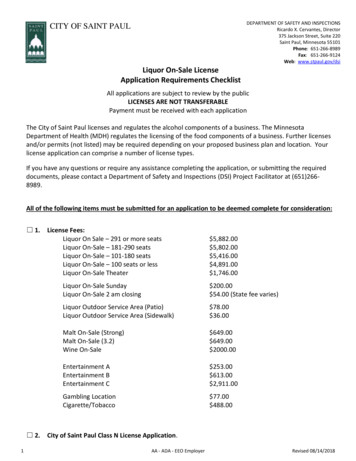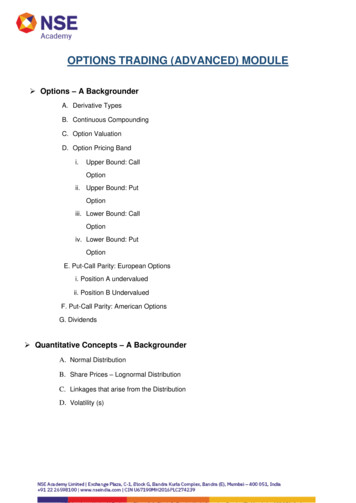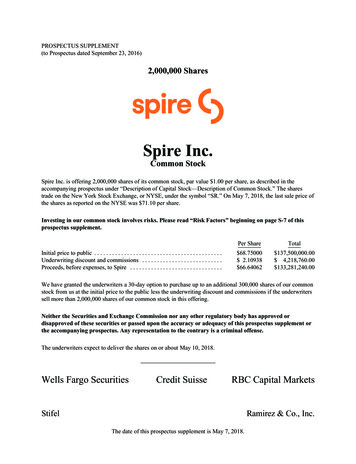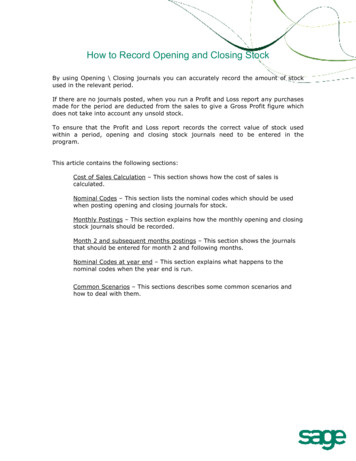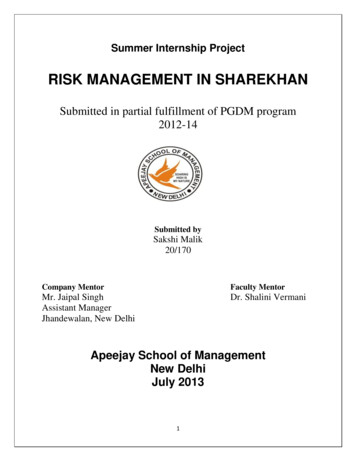
Transcription
SHORT-SALE CONSTRAINTS AND STOCK RETURNSCharles M. JonesGraduate School of BusinessColumbia UniversityOwen A. LamontGraduate School of BusinessUniversity of ChicagoJanuary 2002AbstractStocks can be overpriced when short-sale constraints bind. We study the costs of short-selling equitiesfrom 1926 to 1933, using the publicly observable market for borrowing stock. Some stocks aresometimes expensive to short, and it appears that stocks enter the borrowing market when shortingdemand is high. We find that stocks that are expensive to short or which enter the borrowing market havehigh valuations and low subsequent returns, consistent with the overpricing hypothesis. Size-adjustedreturns are 1% to 2% lower per month for new entrants, and despite high costs it is profitable to shortthem.JEL classification: G14Keywords: Mispricing; Short-selling; Short-sale constraints; Securities lendingWe thank Kent Daniel, Patricia Dechow, Gene Fama, Lisa Meulbroek, Mark Mitchell, Toby Moskowitz,Christopher Polk, Richard Roll (the referee), Richard Thaler, Tuomo Vuolteenaho, and seminar participants atColumbia Business School, Dartmouth, MIT, the NBER, University of Chicago, University of Georgia, Universityof Illinois, University of Michigan, University of North Carolina, University of Notre Dame, and Yale for helpfulcomments. We thank Tina Lam, Frank Rang Yu, and Rui Zhou for research assistance. We thank Gene Fama andKen French for providing data. Lamont gratefully acknowledges support from the Alfred P. Sloan Foundation, theCenter for Research in Securities Prices at the University of Chicago Graduate School of Business, and the NationalScience Foundation.1
1. IntroductionSelling short can be expensive. In order to sell short, one must borrow the stock from acurrent owner, and this stock lender charges a fee to the short seller. The fee is determined bysupply and demand for the stock in the stock loan market. In addition to these direct costs, thereare other costs and risks associated with shorting, such as the risk that the short position willhave to be involuntarily closed due to recall of the stock loan. Finally, legal and institutionalconstraints inhibit investors from selling short. In financial economics, these impediments andcosts are collectively referred to as short-sale constraints.The presence of short-sale constraints means that stocks can become overpriced.Consider a stock whose fundamental value is 100 (i.e., 100 would be the share price in africtionless world). If it costs 1 to short the stock, then arbitrageurs cannot prevent the stockfrom rising to 101. If the 1 is a holding cost that must be paid every day that the short positionis held, then selling the stock short becomes a gamble that the stock falls by at least 1 a day. Insuch a market, a stock could be very overpriced, yet if there is no way for arbitrageurs to earnexcess returns, the market is still in some sense efficient. Fama (1991) describes an efficientmarket as one in which “deviations from the extreme version of the efficiency hypothesis arewithin information and trading costs.” If frictions are large, “efficient” prices may be far fromfrictionless prices.In this paper, we explore overpricing and market efficiency using new, direct evidence onthe cost of shorting. Specifically, we introduce a unique data set that details shorting costs forNew York Stock Exchange (NYSE) stocks from 1926 to 1933. In this period, the cost ofshorting certain NYSE stocks was set in the “loan crowd,” a centralized stock loan market on thefloor of the NYSE. A list of loan crowd stocks and their associated loaning rates was printed2
daily in the Wall Street Journal (WSJ).From this public record, we have collected eight years of data on an average of 90actively traded stocks per month, by far the most extensive panel data set on the cost of shortingever assembled. There is substantial variation in the cost of shorting, both in the cross-sectionand over time for individual stocks. Furthermore, new stocks periodically appear in the loancrowd, and we are able to track the behavior of these stocks both before and after they firstappear on the list. Stocks appear on the list when shorting demand cannot be met by normalchannels, and when stocks begin trading in the centralized borrowing market, they usually havehigh shorting costs. Thus the list conveys important information about shorting demand.This paper makes two contributions. First, we characterize the cost of borrowingsecurities during this period, and are able to say which of the patterns observed circa 2000 arerepeated in our sample, thus broadening the facts presented in D’Avolio (2001) and Geczy et al.(2001). For example, as in current markets, most large-cap stocks can be shorted fairlyinexpensively, but sometimes even large-cap stocks become expensive to short. Small stockstend to be more expensive to short, but only during the first half of the sample. We also quantifythe extent to which the value effect is explainable by shorting costs. Second, and mostimportantly, we show that stocks that are expensive to short have low subsequent returns,consistent with the hypothesis that they are overpriced. Stocks that newly enter the borrowingmarket exhibit especially substantial overpricing. Prices rise prior to entering the loan list, peakimmediately before a stock enters the loan list, and subsequently fall as the apparent overpricingis corrected.By itself, this return predictability is important because it shows that transactions costskeep arbitrageurs from forcing down the prices of overvalued stocks. However, we also find that3
loan crowd entrants underperform by more than the costs of shorting, so it appears that shortingthese stocks is a profitable strategy even after paying the associated costs. Thus not only arethese stocks overpriced, they are more overpriced than can be explained by measured shortingcosts alone. It must be that unwillingness to short (or some other unobserved shorting cost) ispartially responsible for the low returns on stocks entering the loan crowd for the first time.This paper is organized as follows. Section 2 describes the basic hypothesis and reviewsthe literature. Section 3 discusses the institutions and history of short-selling. Section 4describes how we build the sample and shows its main characteristics. Section 5 shows thatstocks that are expensive to short and stocks that enter the loan crowd for the first time have highprices and low subsequent returns. Section 6 summarizes and presents conclusions.2. Theory and existing evidenceShort-sale constraints can prevent negative information or opinions from being expressedin stock prices, as in Miller (1977). Although shorting costs are necessary in order formispricing to occur, they are not sufficient. Shorting costs can explain why a rational arbitrageurfails to short the overpriced security, but not why anyone buys the overpriced security. Thus twothings, trading costs and some investors with downward-sloping demand curves, are necessaryfor substantial mispricing.The Diamond and Verrecchia (1987) model illustrates this point. In their noisy rationalexpectations model, short-sale constraints impede the transmission of private information, but nostock is overpriced conditional on public information. Rational uninformed agents take theconstraints into account, and prices are unbiased because there is common knowledge thatnegative opinion may not be reflected in order flow.4
When shorting a stock, the short seller pays a fee to someone who owns shares. Thus oneinvestor’s cost is another investor’s income. For example, suppose a stock is currentlyoverpriced at 101 and will fall to 100 tomorrow. Suppose that in order to short one share, theshort seller must pay the lender (the owner of the stock) a fee of 1. In this example, both theowner and the short seller are breaking even. However, high shorting costs predict lowsubsequent returns, where returns are calculated in the traditional way (that is, ignoring incomefrom stock lending). We call this stock “overpriced” at 101, although both the owner and thelender are at equilibrium.1However, an important equilibrium condition is that not all shares can be lent out.Somebody must ultimately own the shares and not lend them, so some type of investorheterogeneity is necessary to support this equilibrium. One specific type of heterogeneity is thatthe owning investors are simply uninformed or irrational. For example, Lamont and Thaler(2001) examine a small number of technology IPO’s that they argue are clearly overpriced, havehigh shorting costs, and are probably the result of errors made by investors.To the best of our knowledge, we have assembled the first sample of shorting costs thatcovers a long period of time, so ours is the first paper that can look at cross-sectional returndifferences with any sort of power. D’Avolio (2001), Geczy et al. (2001), Mitchell et al. (2001),Ofek and Richardson (2001), and Reed (2001) all have data covering about a year or less aroundthe year 2000.Because most other researchers have not had direct evidence on the cost of shorting, theyhave instead used indirect measures of shorting costs. One measure is the existence of exchange-1Duffie (1996) develops a model along these lines that examines the impact of lending fees on a security’s price,focusing on the US Treasury market (see also Duffie, Garleanu, and Pedersen, 2001). His main result is that lendingfees will be capitalized into a security’s price. Jordan and Jordan (1997) and Krishnamurthy (2001) provide5
traded options. Options can facilitate shorting, because options can be a cheaper way ofobtaining a short position and allow short-sale constrained investors to trade with other investorswho have better access to shorting. Figlewski and Webb (1993) show that optionable stockshave higher short interest. Sorescu (2000) finds that in the period 1981 to 1995 the introductionof options for a specific stock causes its price to fall, consistent with the idea that options allownegative information to become impounded into the stock price.2.1. Shorting demandInstead of looking at shorting costs, an alternative approach is to look at proxies forshorting demand. If short sellers are better informed or more rational than other investors, theirtrades reveal mispricing. It could be that unwillingness to short, as opposed to shorting costs orinability to short, limits the ability of short sellers to drive prices down to the correct levels.There are many potential short-sale constraints. First, institutional or cultural biasesmight prevent shorting. For example, Almazan et al. (2000) find that only about 30% of mutualfunds are allowed to sell short, and only 2% actually do sell short. Second, for non-centralizedshorting markets one must find a stock lender. This search can be costly and time-consuming.Third, as discussed in Liu and Longstaff (2000) and Mitchell, Pulvino, and Stafford (2001), shortsellers are required to post additional collateral if the price of the shorted stock rises. If they runout of capital, they will need to close their position at a loss. Fourth, stock loans are usually notterm loans, giving rise to recall risk or buy-in risk. The lender of the stock has the right todemand the return of his shares at any time. If the stock lender decides to sell his shares (or forsome other reason calls in his loan) after the shares have risen in price, the short sellers areempirical evidence from the US Treasury market that is broadly consistent with these implications.6
forced to close their position at a loss if they are unable to find other shares to borrow.One measure of shorting demand is short interest, that is, the level of shares sold short.Figlewski (1981), Figlewski and Webb (1993), and Dechow et al. (2001) show that stocks withhigh short interest have low subsequent returns. Unfortunately, using short interest as a proxyfor shorting demand is problematic, because the quantity of shorting represents the intersectionof supply and demand. Demand for shorting should respond to both the cost and benefit ofshorting the stock, so that stocks that are very costly to short will have low short interest. Stocksthat are impossible to short have an infinite shorting cost, yet the level of short interest is zero.Lamont and Thaler (2001), for example, examine a sample of technology carve-outs that appearto be overpriced. In their sample, the apparent overpricing and the implied cost of shorting fallover time, while the level of short interest rises. Thus short interest can be negatively correlatedwith shorting demand, overpricing, and shorting costs. The problematic nature of short interestleads to weak empirical results. Figlewski and Webb (1993), for example, find that short interestpredicts stock returns in the 1973 to 1979 period but not in the 1979 to 1983 period.An alternative measure of shorting demand is breadth of ownership. If short-saleconstraints prevent investors from shorting overpriced securities, then all they can do is avoidowning overpriced stocks. With dispersed private information or differences of opinion,overpriced stocks will tend to be owned by a few optimistic owners. Chen, Hong, and Stein(2001) find evidence in favor of this hypothesis.3. Institutional and historical backgroundThe mechanics and institutional details of short sales in US equity markets have changedlittle in the past century. Unlike the Treasury market and the derivatives markets, the equity7
shorting market has actually regressed in some respects. In this section, we describe the processof selling short, comparing the evidence circa 2000 and the evidence from our sample period of1926 to 1933.3.1. The market for borrowing stockBorrowing shares in order to sell short can be complex. If the investor’s broker has othermargin accounts that are long the stock (or owns the stock himself), the broker accomplishes theloan via internal bookkeeping. Otherwise, the investor’s broker needs to find an institution orindividual willing to lend the shares. Circa 2000, brokers, mutual funds, and other institutions domuch of this lending. Circa 2000, it can be difficult or impossible to find a willing lender forsome equities, especially illiquid small-cap stocks with low institutional ownership.Suppose A lends shares to B and B sells short the stock. When the sale is made, the shortsale proceeds do not go to B but rather to A. The actual term of the loan is one day, though theloans can be renewed in subsequent days. Because A is effectively using collateral to borrow, Amust pay interest to B. When the loan is closed, A repays cash to B and B returns the shares toA. Although sometimes various terms of this transaction (such as the amount of collateralprovided) are negotiated between the two parties, in most cases the interest rate received by B isthe only important variable. This one-day rate, called the “loan rate” or “loaning rate” during oursample and the “rebate rate” now, serves to equilibrate supply and demand in the stock lendingmarket. The rate can be different across stocks and changes from day to day.2Stocks that are cheap to borrow have a high rebate rate. Circa 2000, most large cap2Stock lending between institutions is economically almost identical to the securitized borrowing and lending thattakes place in the fixed income market via repurchase agreements or “repos.” The repo rate corresponds to therebate rate as the variable that equilibrates supply and demand in the borrowing market.8
stocks are both cheap to borrow (the rebate rate is high) and easy to borrow (one can find a stocklender). D’Avolio (2001) and Reed (2001) report that most stocks in their sample are cheap toborrow, and they trade at the general collateral rate, a rate that tracks overnight Fed Funds andother very short-term rates quite closely.Stocks that are expensive to borrow have a low or possibly negative rebate rate. Inmodern lingo, stocks with low or negative rebates are “hot” or “on special.” A negative ratemeans that the institution that borrows shares must make a daily payment to the lender for theright to borrow (instead of receiving interest on the cash collateral posted with the lender). Inour sample, rebate rates of zero are called “flat” and negative rebate rates are “premiums.”Finally, this discussion applies mainly to institutions. Individuals who short (throughtheir brokers) typically receive a rebate rate of zero, both in modern times and in the 1920s(Huebner, 1922, p. 169), with the broker keeping any rebate (unless the stock is loaning at apremium, in which case the individual pays). Further, individual investors who hold stocks inmargin accounts typically do not receive any benefit when their stock is lent out either circa 2000or in our sample (Meeker, 1932, p. 91). In this paper we treat returns from the perspective of abroker trading for himself.In modern data, short-selling is relatively rare and the amount of shares sold short issmall. Our sample is similar. Meeker (1932) reports that total short interest as a percent of totalNYSE shares outstanding was less than 1%, 1929 to 1931, and on November 12, 1929 shortinterest was 0.15% of all shares and 0.12% of market-capitalization. Similarly, Figlewski andWebb (1993) report average short interest as a percent of shares outstanding of 0.2% for the1973 to 1983 period. As of January 1, 1929, Meeker (1932) reports out of 1,287 NYSE stocks,with an average market equity of 55 million, only 33 had short interest greater than 0.59
million. Similarly, Dechow et al. (2001) report that between 1976 and 1993, less than 2% of allstocks have short interest of greater than 5%.3.2. The loan crowdIn our sample period of 1926 to 1933, stock lending was done for some stocks through acentralized market on the floor of the NYSE. A loan crowd met regularly throughout the tradingday on the NYSE floor at the “loan post” in order to facilitate borrowing and lending of sharesbetween members. This market was most active just after the 3:00 p.m. close, as brokersassessed their net borrowing needs at the end of the day’s trading. The result of this centralizedlending market was a market-clearing overnight loan rate on each security, which was reportedin the next day’s WSJ.Table 1 shows two days of stock loan rates, for the last trading day of January 1926 andFebruary 1926. Consider first the data for January. Many of the included stocks, e.g., U.S.Steel, are the largest and most liquid stocks of the time. Next to each stock is printed the loanrate. The example displays the typical features of the data. Most stocks have a loan rate of 3.5%or 4.5%, while a handful have rates of zero. For comparison, the call-money rate at this time was5%, so most stocks are being lent slightly below the call-money rate.3 The data for Januaryshows no stocks trading at a premium (a negative rebate) and a large mass of stocks at a rate ofexactly zero, an unlikely event if rates were continuously distributed in response to supply anddemand.This centralized market for borrowing NYSE stocks no longer exists. Instead, circa 2000stock lending is done via individual deals struck between institutions and brokers. This lack of a3Both call-money and loan rates are closing prices as of the last day of the month. However, there is a slightmismatch in our observations of call loan rates since they are only available on weekdays. In contrast, the NYSEwas open on Saturday during this period. The January 1926 observations on loan rates (as well as CRSP prices)10
central market is why existing studies of the cost of shorting have only limited historical datafrom proprietary sources. In this sense, the shorting market has regressed since our sampleperiod, since rebate rates are no longer centrally determined and publicly observable.On balance, however, except for regulation, the fact that the stock lending market is nolonger centralized does not necessarily mean that shorting is more difficult or expensive todaythan in the 1920s. Most NYSE stocks did not trade in the loan crowd. Table 1 lists 59 stocks forFebruary 1926, while CRSP lists 518 NYSE stocks for the same date, so only 11% of existingstocks got into our sample in that month. Further, of these 59 stocks probably most borrowingnever went through the loan crowd but rather occurred internally within brokers.3.3. The sources of cross-sectional variation in rebate ratesRebate rates reflect supply and demand of shares to lend. Stocks go on special whenshorting demand is large relative to the supply of shares available for lending. Thus, specificstocks can be costly to short either because there is a large demand or a small supply. No matterwhat the reason for the high shorting costs, however, the consequences of the costs are clear.Stocks that are expensive to short can be overpriced since it is expensive to correct theoverpricing. Thus, we do not need to identify the reason for the low rebate rate in order to testwhether it results in overpricing.Demand for borrowing stock can be high, most obviously, because the stock isoverpriced. This speculative demand for shorting is the motivation for studies that try to predictstock returns with short interest. In addition, investors also short for hedging needs. Accountsfrom our sample period describe the familiar arbitrage activity of buying one security andcome from Saturday, January 30, 1926, whereas the call-money rate comes from Friday, January 29.11
shorting another, with trades involving preferred stock, convertible bonds, rights issues, and soon. Unlike modern sample periods with exchange-traded derivatives, shorting individual stocksappears to have been the main way for investors to hedge market risk. In our sample, shortingwas also an important tool for technical purposes such as hedging dealer inventories, theoperations of odd-lot traders and specialists, and selling shares of owners whose sharecertificates were physically distant from the NYSE.Stocks can also be costly to short if their lendable supply is low. In general, small andilliquid stocks are difficult to short for the same reason that they are difficult to buy: it is hard tofind trading partners. More specifically, both circa 2000 and in our sample period, loanablesupply consists of shares owned by financial institutions (such as mutual funds) and shares heldby retail investors in margin accounts at stockbrokers. Accounts of the process circa 2000 stressinstitutional ownership as the determining factor (D’Avolio, 2001). Accounts in our samplestress the importance of stocks held by brokers and individuals buying on margin. Supply variedacross stocks and across time for the same stocks as the amount held in margin accounts varied.In understanding the determinants of the rebate, it is useful to examine an extreme outlierin our sample. Wheeling & Lake Erie Railroad on the last trading day of January 1927 had arebate rate of -290%, representing a daily fee of fifty cents per share for maintaining a shortposition on a stock trading at 62.125. At this time most stocks were lent at (and the call-moneyrate was) 4%, so to borrow this stock one had to sacrifice a 294% annualized return. At onepoint during February 1927 this daily fee rose to an amazing 7 per day.The premium arose in January and February 1927 because of a confluence of factorsdescribed in Meeker (1932). First, in January there was substantial speculation that Wheelingwould be acquired. As it turns out, this speculation was correct. Three other firms together12
bought shares and acquired a 50% stake in Wheeling, and the price rose in January from 27 to 60. As these firms bought common shares, the amount of Wheeling common stock availablefor lending fell. In addition, Wheeling had preferred shares convertible into common stock.Unfortunately, Wheeling had failed to obtain the necessary regulatory authorization from theNYSE and the Interstate Commerce Commission to issue additional common stock. Thus whenholders of preferred shares attempted to convert their shares, their attempt was refused. Hadthese preferred shares been converted, the supply of common would have risen.In addition to low lendable supply, shorting demand for Wheeling during this period wasprobably high. There was both takeover speculation and arbitrageurs who were long Wheelingconvertible preferred and short the common. During the period January 27 to February 9,Wheeling common stock had extremely volatile prices, low volume, and high shorting costs, alldriven by extensive shorting demand intersected with the very low supply of lendable shares. OnFebruary 9th, for example, the common stock price ranged from 105 to 66.75. Thus, it isplausible that arbitrageurs would be willing to pay high holding costs to guard themselvesagainst the extreme volatility in Wheeling. Last, it is worth noting that the extraordinary cost ofshorting only lasted two weeks.3.4. Additions to the list as a indicator of shorting demandWe show later that new entrants tend to enter at high shorting cost, but Table 1demonstrates the general pattern. Table 1 shows that in February 1926, the list growssubstantially as more stocks are added. Unlike the old stocks, which continue to have loan ratesin much the same pattern as January, these 17 new stocks all have loan rates that are zero ornegative (we do not classify United Drug as new since it had been in the loan rate list prior to13
January). The rates are expressed in annual percent terms. Some of the premium rates areextremely high. For example, Chicago and Eastern Illinois Railway loaned at a premium of onesixteenth, which means that a borrower would pay the lender one-sixteenth of a dollar per shareper day (an annual rate of -67%).Why did Chicago and Eastern Illinois get added to the list, and why does it have such anoutlandish cost of shorting? It must be that (compared to January), in February either the supplyof lendable shares fell or the demand for lendable shares rose. According to the WSJ on March1, 1926: “Ask any broker who makes it a practice to lend stocks to the shorts and he will tell youthe demand is heavier than it has been in months.” It appears that for some reason, shortingdemand for Chicago and Eastern Illinois, along with the other 16 stocks, increased in February.This increase in shorting demand drove the stocks into the loan crowd.Ultimately, however, it does not matter whether a stock is added to the list because ofchanges in supply or demand. In either case, the inclusion on the list indicates that there existssubstantial demand for borrowing the stock to short it. Contemporary accounts indicate thatbrokers preferred not to go to the loan crowd if possible. Leffler (1951) describes (p. 283) thealgorithm for borrowing stock. First the broker himself might own it. If not, his customersmight own it in a margin account. If not, other friendly brokers might own it and he wouldcontact them directly. Only after these avenues are exhausted would a broker go to the loancrowd. Meeker (1932, p. 94) says that brokers prefer to settle in house if possible since it savesbookkeeping work and because the broker retains the benefits of lending without sharing it withanother broker.In our empirical work, we focus on new entrants to the loan rate list like the 17 stocksadded at the end of February 1926. Most loan crowd entrants loan below the general collateral14
rate. Other stocks loan below the general collateral rate in our sample. However, the fact that astock has a high shorting cost may not indicate high shorting demand. Dice (1926) comments onthree of the stocks in Table 1: “That a stock is quoted flat may or may not mean that there is alarge short interest in the stock. Delaware & Hudson, United Fruit, and Western Union have lentflat for some years. They are not regularly loaned at any other rate than on a flat basis, that is,the lender refuses to pay interest to the borrower for the money deposited.” Unfortunately, Diceoffers no clues as to why these three stocks lend flat for long periods of time.Thus, a stock’s first appearance on the loan list is perhaps the best indication that shortingdemand is high, so high relative to supply that it cannot be met by internal bookkeeping bybrokers. This measure of shorting demand is superior to short interest because high short interestcan indicate high demand or high supply. For example, US Steel always had relatively highshort interest in this period, but this was because it was easy to short and consequently wastypically used for hedging purposes (in the way modern investors would use S&P futures).4. The sampleWe start by collecting loan rates by hand from the WSJ from December 1919 to October1933. The Journal publishes loan rates on a daily basis; however, since CRSP only has monthlydata for this period, we collect only loan rates for the last trading day of the month. CRSPreturns begin in January 1926. Thus although we have loan rate data for the pre-CRSP period of1919 to 1925, we do not use this data in our analysis because we do not have prices and returnsfor this period. For the period 1926 to 1933, we obtain stock prices, returns, dividends, andmarket equity from CRSP. We also obtain book values from an updated version of the Davis,15
Fama, and French (2000) database.44.1. Developments in the shorting market in the 1920s and 1930sOur sample period of 1926 to 1933 was an eventful time for the US stock market, as thenominal level of stock prices first doubled and then dropped to one-third of the original level.During our sample a major regime shift in the stock loan market occurred in October 1930. Fig.1 demonstrates this regime shift, showing that except for March 1933, no stock had a positiverebate after October 1930. The Fig. shows the fraction of stocks with nonpositive (zero orpremium) rates and the fraction with premium
costs are collectively referred to as short-sale constraints. The presence of short-sale constraints means that stocks can become overpriced. Consider a stock whose fundamental value is 100 (i.e., 100 would be the share price in a frictionless world). If it costs 1 to short the stock, then arbitrageurs cannot prevent the stock from rising to .




